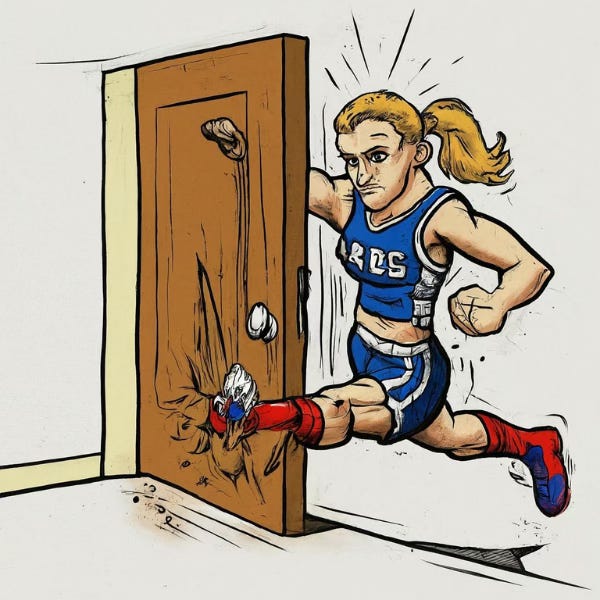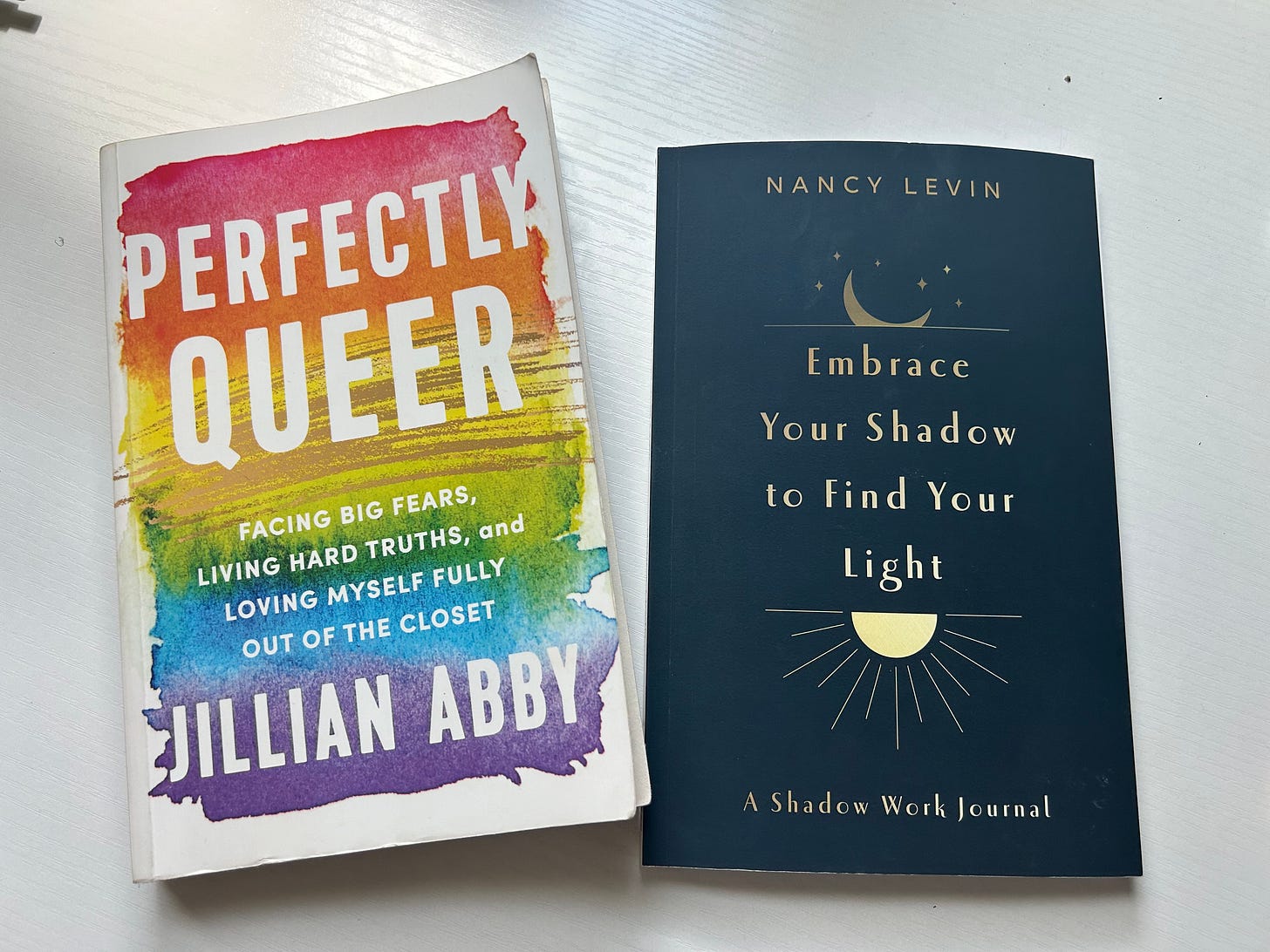Coming out of the closet is not just an LGBTQ+ thing… even if I convinced myself that it was. I remember when my fabulous book editor, Sally, suggested the tagline for my book, “Facing big fears, living hard truths, and loving myself fully out of the closet,” and I felt worried that the only people who would even think to look at my book would be members of the LGBTQ+. (Not to mention the fact that it has a rainbow cover and is titled Perfectly Queer. Fine. There may have been a few factors that made it appear a wee bit on the gay side.)
Regardless, we proceeded forward. I was assured by friends, editors, life coaches, and random internet humans that everyone has a metaphorical closet they hide in. Everyone had aspects of themselves that felt safer to keep hidden from their current reality or the surrounding community. To them, the term “closet” was the same as one’s “shadow self”, a term coined by Swiss psychoanalyst Carl Jung. And as any holistic hippy worth their weight in headbands would know, shadow work is becoming more popular nowadays.
Jung said, “The shadow is that hidden, repressed, for the most part inferior and guilt-laden personality whose ultimate ramifications reach back into the realm of our animal ancestors.” Boy was I glad that back in 2019 I taekwondo chopped my way out of the big queer closet and could now live my closet-free life. From that point forward I could be completely open and free with absolutely ZERO repression to be found. (That was totally me… right? I did it. Closet-0, Jillian-1.)
Seeking a Single-Closet Existence
I attended Hay House Publishing’s I Can Do It event this past March in Phoenix, Arizona. I had the joy of reconnecting with a dear friend and my fairy god author, Nancy Levin, who has been both a mentor and source of inspiration to me as I stepped onto my own author’s path. I was so excited to see that she had a new workbook coming out, Embrace Your Shadow to Find Your Light.
“YES!” I thought. This will help SO many people who are just beginning to understand the concept of their shadow and need help discovering their own closets. I hoped the workbook would help others find the key to open (or side-kick) their own closet doors down just as I had five years ago. I flipped through the workbook, enjoying the mixture of life stories, research, and exercises she had laid out to support people through their own journey of self-discovery. Seemed like a fabulous workbook that clearly wasn’t for me. Because, clearly, I had already done the work. And clearly, she did not just lovingly place a copy in my hands and suggest that I go through it because I clearly had more work to do.
Wait a second…
Was she suggesting that somehow my work wasn’t done? Was she seeing that while I had taken a huge leap in knowing and loving myself, I was still just starting the journey of uncovering, unwinding, and unwrinkling all of the stories and beliefs I held about myself? Could she see that I was still repressing things that I was refusing to address because denying them felt safer and more fun?
I took my signed copy of the soft-covered workbook and gently packed it into my suitcase to explore later when I was in the safety and comfort of my own home. If there was another closet to find, I was going to find it alone while wrapped in a fuzzy blue bathrobe. The concept of self-healing seems great. We celebrate people after the fact— when they kick addictions, escape abusive relationships or religions, or step into their truth. Rarely, though, do we acknowledge the fear, indecision, and truly hard work it takes when someone is at the start of stepping out of their own closet. Often we value victors over participants.
The Truth About Busting Open Closet Doors
While ‘excitement’ wasn’t quite the emotion I was experiencing at the thought of cracking open Nancy’s workbook to start my inner-space exploration again, I was filled with a healthy dose of curiosity about what I might discover. I also felt some degree of comfort in that I already knew what I took to come out of the closet of my sexual identity. I knew I would be in for some degree of judgment from others. That I might lose other people in the process who weren’t aligned with my refined identity and beliefs about myself.

I reminded myself that closets are a space of false safety. We stay in them because they allow us to more easily exist in our communities, at the expense of hiding ourselves. I also knew, though, that it was a faux safety and that coming out of any closet allows you to find your real people— those who love you for your truth and not for the illusion you’ve built for them. I reminded myself that coming out is scary but staying in, for the next year, or decade, or lifetime is scarier. The top regret of the dying is “I wish I’d had the courage to live a life true to myself, not the life others expected of me.”
For me, living with regret feels scarier than sharing the truth. So, back to the closet hunt I went.
New Closet Doors Discovered
I opened the navy cover of Nancy’s workbook, knowing that I already had a sense of the closet doors inside of me. There were the closets that told me to play it small, the closets that insinuated I was not enough, and the closets that told me I was not worthy of being compensated for my value. But the closet door that appeared through Nancy’s exercises was not one I had considered. Identifying it brought up both old and current feelings, beliefs, and biases that I didn’t consciously realize I was carrying around with me. Unlike being gay, which I adamantly denied to myself for a solid decade—this closet door was something that was a regular part of my daily life, and yet with the majority of people, I didn’t discuss it or would even make fun of it. Ah, nothing like a bit of self-deprecating humor to add another padlock to the closet door!
When I shared this new self-discovery with my own life coach, I found myself at an unusual loss for words. I struggled to verbalize what exactly I felt and why I was feeling that way. Shadows and closets are spaces dominated by feelings of shame, judgment, and fear. The feelings I had for this closet space weren’t nearly as over-analyzed or examined as usual. I knew this closet didn’t feel good to me and I had a lot of trepidation about making it a public piece of my identity, but I couldn’t put my finger on the “why.”
Now what?
Since finding the “what” of my closet, the universe is filling in gaps around why I consider this belief about myself to be one of shame or judgment. (Or maybe it’s just the Baader-Meinhof phenomenon, a type of cognitive bias where something you’ve recently learned suddenly seems to be everywhere.) Regardless, I asked the question and now am getting the answers which are helping me creak the closet door more fully open. I am being presented with more and more examples of what feels like “the ick” around this identity. Each encounter is an opportunity to figure out why it doesn’t feel good.
Until I’m fully out, I will continue to examine and test my beliefs around this piece of me and what meaning I’m attaching to the label. As I mentioned in Perfectly Queer, when coming out of any closet one of the greatest gifts we can have is time. Exploring our own closets isn’t a race to see who can open the most doors in the fastest way possible-- it’s a journey of one (hopefully with some supportive friends, coaches, or workbooks) where we do the work to know and love ourselves better.
Note to self: Jillian, when you show up fully, you are giving the best version of yourself to the world






